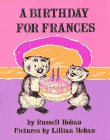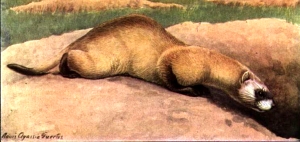| This site will look much better in a browser that supports web standards, but it is accessible to any browser or Internet device. |
Dancing with Badgers:
Mommy, I Want a Wolverine Beanie Baby
Skunks and otters have made their way into our children's hearts, thanks in no small part to Disney Studios. Flower, Bambi's sweet little friend, is the only carnivore on the Bambi cast list. And my introduction to otters was a segment of a Disney nature film in which river otters were shown playing in a mountain stream (rather than, say, chewing the heads off trout).

Through the efforts of Russell Hoban, assisted by Lillian Hoban's illustrations, children are seeing badgers in a positive light. The Frances series, a charming collection of books for pre-school children featuring a young badger, began about the time my son was born.

Another much-beloved children's book with a badger as its central figure is Badger's Parting Gifts, by Susan Varley.
As far as I can tell, there has never been a badger Beanie Baby. Or a weasel. Nor, for that matter, a wolverine. Image is all; nobody is handling PR for the mustelids. In contrast, it has been an amazing exercise in image-modification to watch the wolf transformed, in twenty years, from a creature of evil to a noble symbol of American wilderness. Wolves, once the truth got told, fit the bill nicely, with their canine agreeableness, sociability, intelligence, and fortunate resemblance to "man's best friend."
So the same people who used to think of wolves as cowardly killers have lately forgotten that their canid soulmates are also carnivorous opportunists who would never give a mother deer a fighting chance, that they will disable their prey by gutting it on the run, that there are reputable reports suggesting their social rules include killing their own aged, worthless, or infirm. Not that I hold any of this against them, mind you, but we can't we ever see the whole animal, warts and halo?
I have a collection of badger/weasel/wolverine knick-knacks gathered up absent-mindedly over the years. Well, no wolverines. Whenever I'm in a store that sells stuffed animals or animal figurines, I always check for my mustelids. I've found a half dozen badgers, mainly European — an antique British badger nearly as old as I am, for example, a real badger skull, and a treasured quartz badger fetish from New Mexico — plus an otter, a ferret, and a few weasels, including a beautiful Russian ceramic of a white ermine (with an egg in his mouth, of course). But no wolverines. Not even during my brief sojourn in Canada.
|
Good News!! A reader has found a plush wolverine! The Cascade Toys line now includes a wolverine, two otters, and a skunk. Cascade Toys website is not a retail outlet, but their products are available in toy and novelty shops. Inspired by Lyn's discovery, I searched anew and found a few more wolverines, badgers, and such (including Farrah, who is a discontinued model; sigh), at AllPlush.com. Annnnd: The World Wildlife Fund recently added wolverines to their "adoptable" animals, so I am now the happy owner of a plush wolverine. Hurray! |
The ferret, specifically the endangered black-footed ferret, is the only weasel who's made it to the pop charts. My wife Trudy and I had, in our very selective collection of stuffed animals, a larger than lifesize black-footed ferret named Farrah Fawcett Ferret, and I recently got a pair from the aforementioned WWF adoption site. My theory about America's adoption of the black-footed ferret as a "good animal," is that it was largely the result not of ecological awareness but of the accident that the creature was not known as the "black-footed weasel." In fact, it is sometimes identified as a "black-footed weasel" in web documents, and I can't help but wonder if some marketing genius saved its life with a slight revision in nomenclature similar to the transformation of the sparrow hawk into the American kestrel.

I recently found this picture by Louis Agassiz Fuertes, of a "Black-Footed Ferret," which originally appeared in National Geographic nearly a century ago. So the name change, if there has been one, is not recent.
All cultures, it seems, moralize the natural world, so it is something we simply have to live with, part of our imaginative makeup. What hurts, of course, is moralizing that teaches hatred and disrespect for animals who mean us no harm. When the Pueblo Indian goes hunting deer and offers the corpse of his prey respectful gifts, explanations, and apologies, we don't have to believe that the deer care for us or that they accept our apologies in order to approve the impulse. The hunter's attitude is the point, the respect for another's life.
No doubt the wolf enjoys running down an exhausted deer, and the deer gets no pleasure from the chase. But fundamentally, the wolf is not chasing the deer for the same thrill as that sought by snowmobilers who chase a coyote, a fox, or a stray dog till the terrified creature's heart bursts, nor is it the refined enjoyment felt by the fox hunter when his gang of savage lapdogs catch the fox at last and tear it to bits. The wolf is just hungry.
Yeah, Buffy the Wolf Cub may grow up some day to eat Bambi's cute kids. But it's nothing personal.
The Topics
- Dancing with Badgers — Introduction
- Learning Mink — The Beginnings of a Fascination
- Badgers? Dancing? — Where We Got "Dancing Badger," and How
- The Least Among Us — Weasels as Heroes and Villains
- Farrah Fawcett Ferret — The Black-Footed Ferret Who Loved Me
- Skunks May Be Mommies — My Niece Meets a Stereotype
- To the Last Wolverine — Encounters with the Spirit of the Wild
- Tanuki Kami Is a Dharma Bum — Raccoon, Badger, Tanuki: What Was Your Name Again?
- Who Are Those Guys? — A Survey of an Impolite Family

|
|